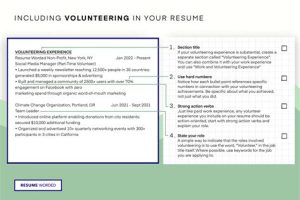Table of Contents
Discover the importance of volunteer job descriptions and how they play a crucial role in recruiting and managing volunteers effectively. This article explores what volunteer job descriptions entail, including key elements such as responsibilities, qualifications, and time commitments. Learn how to create clear and concise job descriptions that attract passionate individuals willing to contribute their time and skills to your organization’s mission.
The role of a volunteer is often underestimated, as many people assume that it simply involves giving up their time for free. However, the reality is far more complex and rewarding. In order to truly understand the value of volunteering, it is essential to explore the intricacies of a volunteer job description. This document not only outlines the tasks and responsibilities of the position but also serves as a window into the immense impact that volunteers can have on organizations and communities. By delving into the specifics of a volunteer job description, one can uncover the unique opportunities for personal growth, skill development, and making a difference in the world.
The Importance of a Volunteer Job Description
Volunteering is a selfless act that allows individuals to give back to their communities and make a positive impact on the world. Many organizations rely heavily on volunteers to carry out their missions and achieve their goals. However, in order for volunteers to effectively contribute their time and skills, it is crucial for organizations to provide them with a clear and comprehensive job description.
Defining Roles and Responsibilities
A volunteer job description serves as a roadmap, outlining the specific roles and responsibilities of each volunteer position. It helps both the organization and the volunteer establish clear expectations from the onset. By clearly defining what is expected of volunteers, organizations can ensure that they are utilizing their skills and time efficiently, while volunteers can have a better understanding of their tasks and how they can contribute.
Setting Clear Expectations
Volunteers often come from diverse backgrounds and may have varying levels of experience and expertise. A well-crafted job description provides a clear understanding of the skills and qualifications required for the volunteer role. This ensures that volunteers who apply for the position possess the necessary abilities and knowledge to perform their duties effectively.
Enhancing Volunteer Recruitment
A detailed job description not only sets expectations but also attracts potential volunteers. When organizations provide a clear outline of the volunteer positions available, it becomes easier for interested individuals to identify roles that align with their interests and skills. This helps organizations attract volunteers who are genuinely passionate about the cause and are more likely to commit their time and effort in the long run.
Creating a Sense of Purpose
A well-defined job description helps volunteers understand how their efforts contribute to the overall mission of the organization. It provides them with a sense of purpose and fulfillment, knowing that their work makes a meaningful difference. By clearly stating the objectives and impact of each volunteer role, organizations can inspire and motivate volunteers to give their best.
Providing Structure and Guidance
Volunteering can sometimes be overwhelming, especially for individuals who are new to the organization or the specific role. A job description provides structure and guidance, helping volunteers navigate their responsibilities and tasks. It outlines the reporting structure, points of contact, and any necessary training or orientation required. This ensures that volunteers feel supported and empowered to fulfill their role.
Efficient Volunteer Management
In addition to aiding volunteers, a comprehensive job description is beneficial for organizations in managing their volunteer programs effectively.
Streamlining Recruitment and Selection
When organizations have a clear understanding of the roles and responsibilities required for each volunteer position, they can streamline the recruitment and selection process. By matching the skills and qualifications of applicants with the job description, organizations can ensure that they are selecting candidates who are the best fit for the role. This saves time and resources for both the organization and the volunteers.
Performance Evaluation and Feedback
A volunteer job description also provides a solid foundation for evaluating volunteer performance and providing feedback. By having a clearly defined set of responsibilities, organizations can assess how well volunteers are fulfilling their duties and recognize areas for improvement. It allows for open communication between the organization and volunteers, fostering a positive and supportive environment.
Conclusion
A volunteer job description is an essential tool that benefits both organizations and volunteers. It defines roles and responsibilities, sets clear expectations, attracts suitable candidates, creates a sense of purpose, provides structure and guidance, and aids in efficient volunteer management. By investing time and effort in creating comprehensive job descriptions, organizations can maximize the impact of their volunteers and create a rewarding experience for all parties involved.
Is Volunteer Job Description
A volunteer job description is a comprehensive document that outlines the responsibilities, duties, and expectations associated with a specific volunteer position within an organization. It serves as a guide for potential volunteers, providing them with a clear understanding of the role they will be fulfilling and the impact they will have on the organization’s goals and objectives.
1. Position Title and Summary
The position title and summary are crucial in conveying the purpose and scope of the volunteer role. By clearly defining the title and providing a concise overview, potential volunteers can quickly assess whether the position aligns with their interests and skills. For example, a position could be titled Volunteer Program Coordinator and involve managing various aspects of the volunteer program, facilitating communication between volunteers and staff, and ensuring the smooth running of volunteer initiatives.
2. Essential Duties and Responsibilities
The essential duties and responsibilities section outlines the specific tasks and responsibilities that the volunteer will be expected to perform. It should reflect the goals and objectives of the organization, ensuring that the volunteer’s efforts contribute to the overall mission. For example, a volunteer coordinator may be responsible for coordinating volunteer recruitment, screening, and selection processes, as well as developing and maintaining volunteer training materials and orientation sessions.
3. Time Commitment and Schedule
The time commitment and schedule section provides potential volunteers with a clear understanding of the expected time commitment for the position. This includes the number of hours per week and the duration of the assignment. Additionally, any flexibility or specific timeframes should be outlined to ensure that potential volunteers can assess whether they can meet the requirements. For instance, volunteers may be required to commit to a minimum of 10 hours per week for a duration of six months, with the flexibility to choose their preferred days and times within the organization’s operating hours.
4. Qualifications and Skills
The qualifications and skills section lists the specific requirements and preferred qualifications for the volunteer position. It highlights the skills, experience, and education that are directly relevant to the tasks and responsibilities outlined in the job description. For example, a volunteer coordinator may require a bachelor’s degree in a related field or equivalent practical experience, excellent verbal and written communication skills, and strong organizational and interpersonal skills.
5. Training and Support
The training and support section describes the resources and support available to volunteers to enable them to succeed in their roles. This can include formal training programs, mentorship opportunities, and ongoing support from staff members. By highlighting these opportunities, potential volunteers can see that they will receive the necessary guidance and assistance to fulfill their responsibilities effectively. For instance, volunteers may receive comprehensive orientation and training upon joining the organization, specific position-related training, and ongoing support from experienced volunteers.
6. Benefits and Recognition
The benefits and recognition section outlines any perks or rewards that volunteers may receive for their time and effort. This can include professional development opportunities, networking possibilities, and recognition programs implemented by the organization to acknowledge their valuable contributions. By highlighting these benefits, potential volunteers can see the value they will gain from their volunteering experience. For example, volunteers may have the opportunity to gain professional experience, expand their network, and receive certificates of appreciation, letters of recommendation, and recognition on the organization’s website and social media platforms.
7. Code of Conduct
The code of conduct section clearly communicates the organization’s expectations regarding appropriate behavior and professionalism. It emphasizes the importance of maintaining confidentiality, respecting colleagues and clients, and adhering to the organization’s values and principles. By outlining the code of conduct, potential volunteers can understand the behavioral expectations set by the organization. For example, volunteers may be expected to maintain professionalism, adhere to the organization’s code of conduct, and respect the confidentiality of sensitive information.
8. Reporting and Supervision
The reporting and supervision section specifies the reporting structure and level of supervision provided to volunteers. It identifies the point of contact for any questions, concerns, or issues that volunteers may encounter while performing their duties. By providing this information, potential volunteers can understand the support system in place and who they can turn to for assistance. For instance, volunteers may report to a Volunteer Program Coordinator who will provide ongoing supervision and serve as the primary point of contact for volunteer-related inquiries.
In conclusion, a well-written volunteer job description is essential for attracting and engaging potential volunteers. By incorporating the position title and summary, essential duties and responsibilities, time commitment and schedule, qualifications and skills, training and support, benefits and recognition, code of conduct, and reporting and supervision, organizations can effectively communicate their expectations and provide a clear understanding of the volunteer role.
Volunteer job descriptions should indeed use a professional voice and tone to effectively communicate the expectations and responsibilities of the role. Here are some points to consider:
1. Clear and concise wording:
- The job description should use clear and straightforward language that is easy to understand for potential volunteers.
- Avoid using jargon or technical terms that may confuse readers who are not familiar with the organization or the specific field of work.
- Ensure the information provided is concise, highlighting the key aspects of the volunteer position.
2. Professional tone:
- The tone of the job description should be professional and respectful.
- Avoid using overly casual or informal language, as it may not convey the seriousness of the role or the organization.
- Emphasize the importance of commitment, reliability, and professionalism in fulfilling the volunteer duties.
3. Inclusive language:
- Use inclusive language that encourages individuals from diverse backgrounds to apply for the volunteer position.
- Avoid any discriminatory language or statements that could exclude potential volunteers based on their race, gender, religion, age, or other protected characteristics.
- Highlight the organization’s commitment to diversity, equity, and inclusion in the volunteer job description.
4. Highlighting benefits:
- Include any benefits or perks that volunteers may receive while serving in the role.
- This could include training opportunities, networking events, references for future job applications, or any other relevant incentives.
- Clearly communicate the impact and value that volunteers bring to the organization and the community.
5. Accurate and up-to-date information:
- Ensure that the job description is up to date and accurately reflects the current needs and requirements of the volunteer role.
- Include specific details such as time commitments, location, and any necessary qualifications or skills.
- Clearly outline the tasks and responsibilities expected from volunteers to avoid any misunderstandings.
In conclusion, a volunteer job description should be written using a professional voice and tone to effectively convey the expectations, responsibilities, and benefits of the role. By using clear and concise language, inclusive terminology, and accurate information, organizations can attract suitable volunteers who are committed and aligned with their mission.
Dear Valued Blog Visitors,
As we come to the end of this blog post, we hope that you have gained a comprehensive understanding of the volunteer job description and its significance in today’s society. Throughout this article, we have explored the various aspects of volunteering and its impact on individuals as well as communities. It is imperative to note that even though volunteer positions may not come with fancy titles, they hold immense value and contribute significantly to personal growth and societal development.
Firstly, it is crucial to acknowledge that volunteer work goes beyond the boundaries of traditional job descriptions. While paid positions often come with predefined roles and responsibilities, volunteers have the opportunity to explore different areas of interest and make a meaningful impact in various ways. Without the constraints of a specific title, volunteers can freely engage in activities that align with their passions and strengths, allowing for a more fulfilling experience. Transitioning from a professional setting to a volunteer environment provides a unique chance to step out of one’s comfort zone and develop new skills while making a difference.
Secondly, the absence of a formal job title should not undermine the significance of volunteer work. In fact, volunteer experiences can enhance one’s professional profile and be seen as valuable assets by potential employers. Engaging in volunteer activities showcases qualities such as selflessness, compassion, and commitment, which are highly sought after in today’s competitive job market. Employers value candidates who demonstrate a willingness to contribute to their community and possess a broader perspective on societal issues. Therefore, volunteering can serve as an excellent platform to expand your network, gain references, and open doors to future career opportunities.
In conclusion, volunteering is a form of service that transcends the limitations of job titles. It allows individuals to make a positive impact, both on themselves and the world around them. By embracing the opportunities that volunteer work offers, you can grow personally and professionally, all while making a difference in the lives of others. So, whether you are a seasoned volunteer or considering taking your first step into this realm, we encourage you to explore the various volunteering opportunities available and discover the power of giving back.
Thank you for accompanying us on this journey of understanding the volunteer job description. We hope that this article has inspired you to embark on your own volunteering journey and experience the countless rewards it brings.
Warm regards,
The Blog Team
Video Is Volunteer Job Description
People also ask about Volunteer Job Description:
What should be included in a volunteer job description?
- The name of the organization or project where volunteers will be working.
- A clear and concise title for the volunteer position.
- A summary of the tasks and responsibilities involved in the role.
- The desired qualifications or skills required for the position.
- The time commitment expected from volunteers, including the number of hours and the duration of the commitment.
- Any specific training or orientation sessions that volunteers need to attend.
- Details about any benefits or perks associated with the volunteer position.
- Contact information for individuals who can provide further details or answer questions about the role.
Why is a volunteer job description important?
- It helps potential volunteers understand the expectations and requirements of the role.
- It ensures that volunteers have a clear understanding of the tasks they will be performing.
- It assists organizations in attracting individuals who possess the necessary skills and qualifications for the position.
- It provides a framework for evaluating and managing volunteer performance.
- It helps prevent misunderstandings or mismatches between volunteers and organizations.
- It allows volunteers to make informed decisions about whether the position aligns with their interests and availability.
How do you write a volunteer job description?
- Start with a clear and attention-grabbing title that accurately reflects the role.
- Provide a brief overview of the organization or project where volunteers will be working.
- Clearly outline the tasks and responsibilities involved, using concise language.
- Specify any required qualifications or skills, as well as desired qualities or attributes.
- Include details about the time commitment expected from volunteers.
- Highlight any training, orientation, or support provided to volunteers.
- Mention any benefits or perks associated with the volunteer position.
- Include contact information for individuals who can provide further information or answer questions about the role.
A volunteer job description should include the following:
A volunteer job description is important because:
To write an effective volunteer job description:
By providing a comprehensive and well-written volunteer job description, organizations can effectively attract and engage volunteers who are the right fit for their needs.






